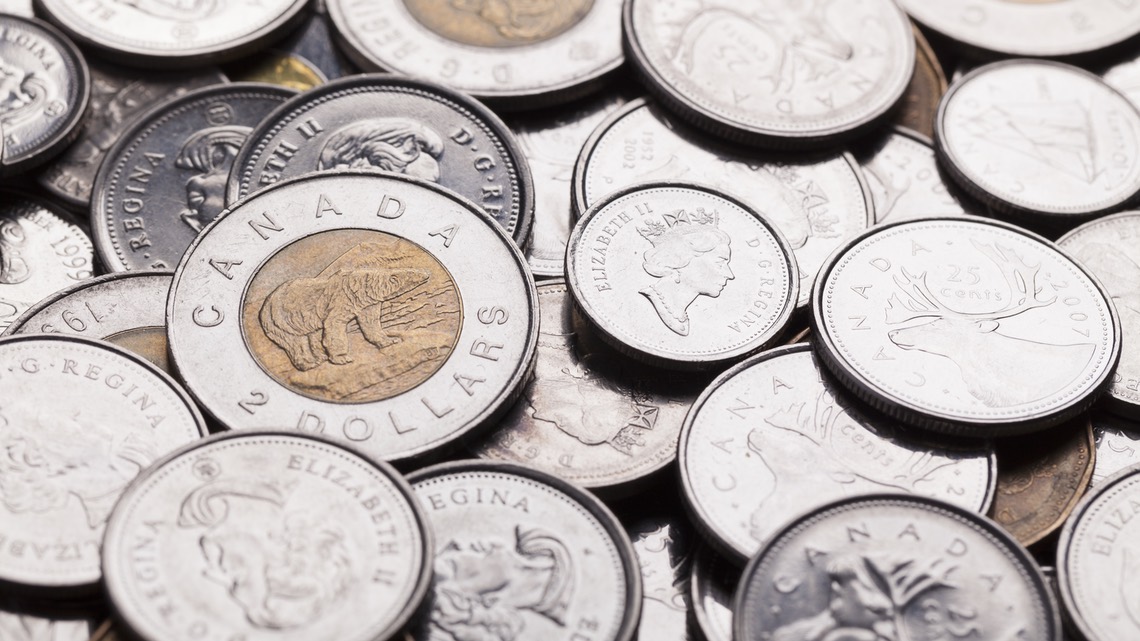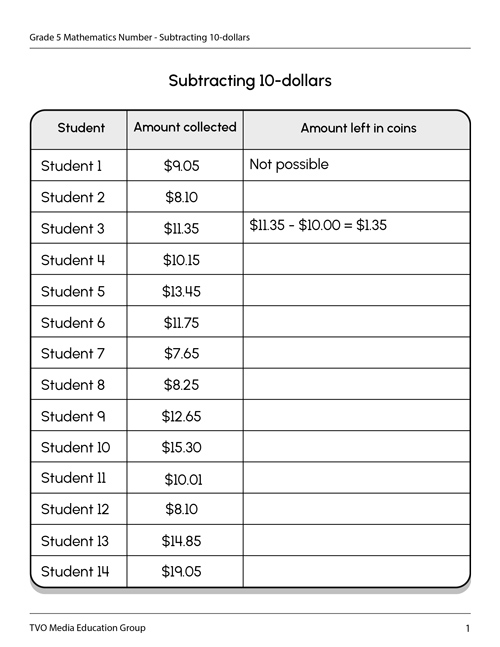Minds On
Using money as a tool

Money can be a very useful tool in learning math. It can be used to model and help us understand many different topics that we learn about, not just saving and spending!
Money can be an especially useful tool to help us understand place value and decimals in particular. For example, one hundred cents is equal to one dollar!
Did You Know?
The Canadian penny

Did you know that in Canada we had a coin to represent one cent? It is called the penny!
In February of 2013, the penny stopped being made and given out by banks and stores because it cost more to make it and circulate it than it was worth!
The penny is still considered a legal form of money and is a very useful tool when learning different math concepts even though it is no longer in use in Canada.
This learning activity uses the penny to represent one cent, or one hundredth of a dollar, to help explore and understand the value of one unit and how it can be combined to make other values.
Examine this TVO Homework Zone video called “Understanding Money” to review some Canadian coins and connections between them.
Examine the following chart to explore the connection between different Canadian coins and their value written as a decimal (in dollars).

A penny equals 1 cent, which equals 1 hundredth of a dollar. A nickel equals 5 cents, which equals 5 hundredths of a dollar. A dime equals 10 cents, which equals 10 hundredths or 1 tenth of a dollar. A quarter equals 25 cents, which equals 25 hundredths of a dollar. A loonie equals 100 cents, which equals 1 dollar. A toonie equals 200 cents, which equals 2 dollars.
- How many cents are in a nickel, in a dime, in a quarter, in a dollar?
- How many nickels are in a dime, quarter and in a dollar?
- How many dimes are in a quarter and in a dollar?
- How many quarters are in a dollar and a toonie?
- How many dollars are in a toonie?
Record your answers in print, digitally or using an audio recording.
Explore the following place value chart. How is each coin amount represented?
 Description
Description
Money place value chart from one thousands to hundredths. For a penny there is a 0 in the ones column, a 0 in the tenths column, and a 1 in the hundredths column. For a nickel there is a 0 in the ones column, a 0 in the tenths column, and a 5 in the hundredths column. For a dime there is a 0 in the ones column, a 1 in the tenths column, and a 0 in the hundredths column. For a quarter there is a 0 in the ones column, a 2 in the tenths column, and a 5 in the hundredths columns.
Did You Know?
Did you know?
When we read decimal numbers, we use the word “and” to represent the decimal.
For example, the number 19.26 is read as:
nineteen and twenty-six hundredths
If we are reading money amounts, we also use “and” to represent the decimal, however, we would use money vocabulary instead.
For example, the amount of $19.26 is read as:
nineteen dollars and twenty-six cents
Let’s try!
Explore the following numbers.
- 10.65
- $19.27
Using a method of your choice, record how each number would be expressed in words.
Press ‘Answer’ to access how each number is expressed.
10.65 is expressed as ten and sixty-five hundredths
$19.27 is expressed as nineteen dollars and twenty-seven cents
In this learning activity, you will learn how to read decimal numbers up to hundredths, round decimals to the nearest tenth, and add and subtract whole and decimal numbers that add up to no more than decimal hundredths.
Action
Adding decimal numbers
Explore this TVO mini-lesson called “Adding two-digit numbers” to learn about adding two-digit numbers with decimals.
Numbers to the left of the decimal are whole numbers and numbers to the right of the decimal are part of a number. In the example, remember that it is not just a number "3" to the right of the decimal but that the 3 represents 3 hundreths and the 8 represents 8 hundreths.
Rounding Numbers
Let’s practice rounding some numbers!
Rounding makes a number simpler to work with and easier to compare with other numbers.
Explore the following numbers.
Round each of the following numbers to the nearest tenth.
Next, round each number to the nearest whole number.
Record your answers using a method of your choice.
| Number | Nearest tenth | Nearest whole |
|---|---|---|
| 9.05 | ||
| 8.10 | ||
| 11.35 | ||
| 10.15 | ||
| 13.45 |
Student Success
Think
Once you have completed rounding the amounts, it’s time to add them up!
- Add up the numbers rounded to the nearest tenth
- Add up the numbers rounded to the nearest whole
Is it more precise to round to the nearest tenth or the nearest whole number?
Share your thoughts with a partner, if possible.
Subtracting decimal numbers
When we subtract decimal numbers, we can use similar strategies as we do when adding decimal numbers.
Examine the following tips for adding and subtracting decimal numbers.
 Description
Description
When adding and subtracting decimals and money, you should line up the decimals, bring down the decimal, do the same for subtracting, and always put the larger number on top!
Exchanging coins for bills

Imagine a school is collecting coins for a coin drive. People can donate their extra change to charity. A group of students collected different amounts of money.
The students end up with a lot of coins. They would like to exchange coins for bill. One of the students decided to try exchanging their coins at the bank. Banks will often help customers exchange coins for bills.
The student had a total of $19.05.
They exchange most of their coins and leave the bank with a $10 bill and a $5 bill. How many coins do they have left?
Press ‘Answer’ to access a sample solution.
10 + 5 = 15
19.05
− 15.00
4.05
They have $4.05 left in change.
Examine the following chart to identify which students might exchange $5.00 worth of change for one five-dollar bill. Calculate the total they will have leftover.
Complete the Subtracting 5-dollars chart in your notebook or using the following fillable and printable document. If you would like, you can use speech-to-text or audio recording tools to record your thoughts.
Ten-dollar bills
Next, examine the following chart to identify which students might exchange $10.00 worth of change for one ten-dollar bill. Calculate the total they will have leftover.
Complete the Subtracting 10-dollars chart in your notebook or using the following fillable and printable document. If you would like, you can use speech-to-text or audio recording tools to record your thoughts.
Consolidation
Fundraising goals

Task 1: How much is left?
5 students decided to create a fundraising goal. Compare their goals to the amount they have collected.
How much more do they need to fundraise to reach their goals?
Record your answers in print, digitally or using an audio recording.
| Student | Student goal | Collected | Amount to meet goal |
|---|---|---|---|
| Student 1 | $20.50 | $9.05 | |
| Student 2 | $15.25 | $8.10 | |
| Student 3 | $33.25 | $11.35 | |
| Student 4 | $20.55 | $10.15 | |
| Student 5 | $13.97 | $13.45 |
Task 2: Rounding up
Next, round each amount collected to make the numbers easier to compare.
- Round each amount collected to the nearest tenth
- Round each amount collected to the nearest whole number
Record your answers in print, digitally or using an audio recording.
| Collected | Round the amount collected to the nearest tenth | Round the amount collected to the nearest whole number |
|---|---|---|
| $9.05 | ||
| $8.10 | ||
| $11.35 | ||
| $10.15 | ||
| $13.45 |
Which number is greatest?
Which number is least?
Student Success
Think
Once you have completed rounding the amounts, it’s time to add them up!
- add up the numbers rounded to the nearest tenth
- add up the numbers rounded to the nearest whole
Is it more precise to round to the nearest tenth or nearest whole number?
Share your thoughts to a partner, if possible.
Reflection
As you read through these descriptions, which sentence best describes how you are feeling about your understanding of this learning activity? Press the button that is beside this sentence.
I feel...
Now, record your ideas using a voice recorder, speech-to-text, or writing tool.
Connect with a TVO Mathify tutor
Think of TVO Mathify as your own personalized math coach, here to support your learning at home. Press ‘TVO Mathify’ to connect with an Ontario Certified Teacher math tutor of your choice. You will need a TVO Mathify login to access this resource.
TVO Mathify (Opens in a new tab)
